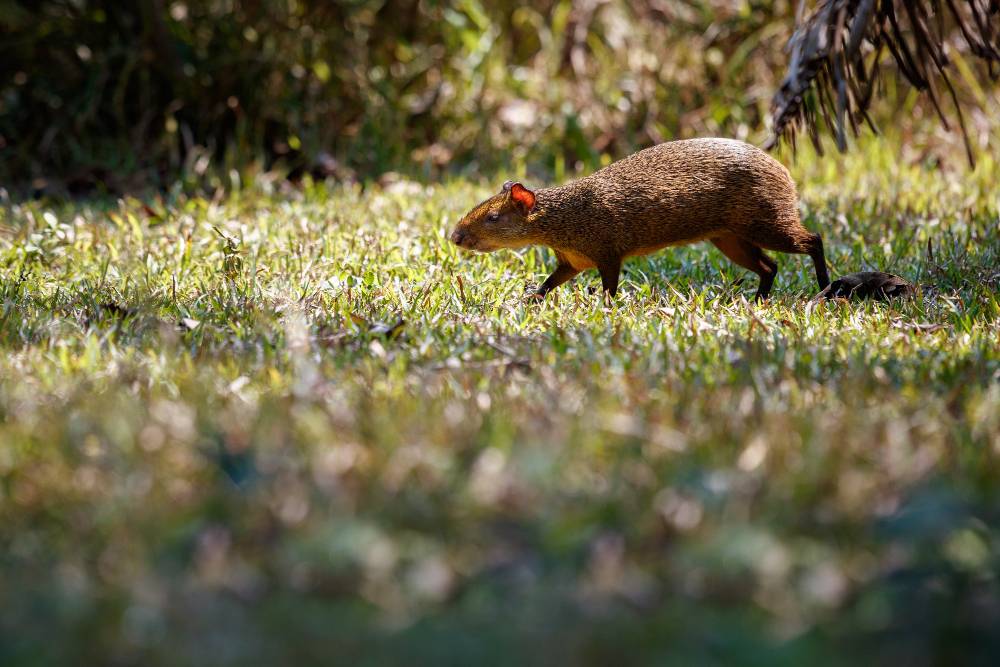Menu

Roger A. Baldwin, UC Wildlife Pest Management Advisor, Kearney Agricultural Center
Pocket gophers cause extensive damage to many crops throughout California. Many tools are available for controlling gophers including trapping, fumigation with aluminum phosphide, poison baits, and the use of a gas explosive device. Trapping gophers has been a common method for controlling gophers for many years.
However, a new trap called the Gophinator (Trapline Products, Menlo Park, Calif.) is now available that may increase efficiency of trapping.
Additionally, combining aluminum phosphide fumigation with trapping may increase effectiveness, as gophers will occasionally spring traps without getting captured. In these situations, gophers often become trap shy and are much more difficult to capture. Treating these tunnel systems with aluminum phosphide shortly after trapping could remove these individuals from the population thereby increasing gopher control in vineyards.
Poison baiting with strychnine, zinc phosphide, and anticoagulant baits (e.g., chlorophacinone and diphacinone) has often been used to control gophers.
Efficacy of these treatments has varied widely, although strychnine baits reportedly are most effective. Gas explosive devices have been used to control a number of burrowing animals, although no scientific studies on gophers have been reported. These devices combust a mixture of propane and oxygen within tunnel systems, thereby killing gophers through concussive force while also destroying the burrow system. All of these methods are currently allowable techniques for controlling gophers in California, although the efficacy and efficiency of these approaches, particularly in comparison to one another, remain unclear.
To better address these issues, I established a replicated trial at Laguna Ranch, Sebastopol, Calif., from April 6 to May 8, 2009, to estimate the efficacy and efficiency of these approaches. Three study blocks were established ranging from 21–31 acres in size.
Plots of all three treatment types (trapping + aluminum phosphide, baiting with strychnine, gas explosive device [Rodenator]) and a control were established within each block. Based on absolute indices (number of sites with any gopher sign after treatment/number of sites with any gopher sign before treatment), Rodenator control ranged from zero to 55 percent, baiting control ranged from 30 percent to 56 percent, and trapping + fumigation ranged from 74 percent to 90 percent.
Relative index values (number of gopher mounds and feeder holes after treatment/number of gopher mounds and feeder holes before treatment) mirrored absolute indices, with substantial reductions in gopher sign for all trapping + fumigation plots (range = 91 percent to 96 percent); only 2 of 3 baiting (range = 22 percent to 81 percent) and Rodenator (range = zero to 86 percent) plots indicated substantially reduced gopher sign. Index values did not differ for control plots for either absolute or relative indices. Therefore, observed differences within and across treatments did not appear to be an artifact of natural variation in gopher populations over the sampling period.
The time required to apply each treatment was relatively similar between baiting, trapping, and Rodenator treatments (90–106 seconds); fumigation treatments were substantially longer (260 seconds).
Total costs for each treatment were $7,568, $6,338, and $4,532 for baiting, Rodenator, and trapping + fumigation, respectively.
To be effective, control measures need to result in a minimum of a 70 percent reduction in plots with gopher activity; values of 80 percent to 90 percent are preferable. Trapping + fumigation met this minimum criterion in all three plots, and met the more rigorous criterion in 2 of 3 plots. Even the one plot that fell short of an 80 percent reduction in plots with gopher activity yielded a 92 percent reduction in overall gopher activity. In addition to being more efficacious, trapping + fumigation was also more cost effective. Therefore, trapping + fumigation appears to be an effective method for controlling gophers. Baiting and Rodenator treatments did somewhat reduce gopher activity in most plots, but these levels of control fell well below the minimum threshold for effectiveness (70 percent). As such, growers may realize short-term benefits from control, but will have to apply equal effort for control the following year. More effective control measures (80 percent to 90 percent) should reduce the cost of control in subsequent years.
Although absolute values were lower than desired for baiting and Rodenator treatments, relative index values indicated a substantial reduction in gopher activity for 2 of 3 plots for both baiting and Rodenator treatments.
Therefore, an additional round of treatments could have resulted in greater absolute control values, although additional treatments would add additional costs to control efforts. This is of note, as baiting, and in particular, Rodenator, treatments have the potential for slowing reinvasion rates due to the destruction of gopher burrow systems by the Rodenator, and due to residual bait remaining in vacated gopher tunnel systems.
However, given that these treatment types were already more costly than trapping + fumigation, a relatively high reduction in reinvasion rates would be required to offset these costs. These reinvasion rates are starting to be assessed. Initial results have hinted that Rodenator treatments may in fact be reducing gopher populations several months post-treatment, although several more sampling periods will be required to determine if this is in fact the case.
Presently, trapping + fumigation appears to be the most effective and efficient method for gopher control.
Guys came on time did their job in a very professional way and we are very happy with their service.
Company is on top of their game David showed up to get are gophers. came out three days in a row haven’t seen a go for since
Joseph is a great ambassador for Wheeler's pest control, and a shout out to Daniel for dealing with my crazy schedule. Thanks guys!
A local business that everyone should support. All techs are knowledgeable, professional! FYI, they are also great w/ eradicating gophers as well!!